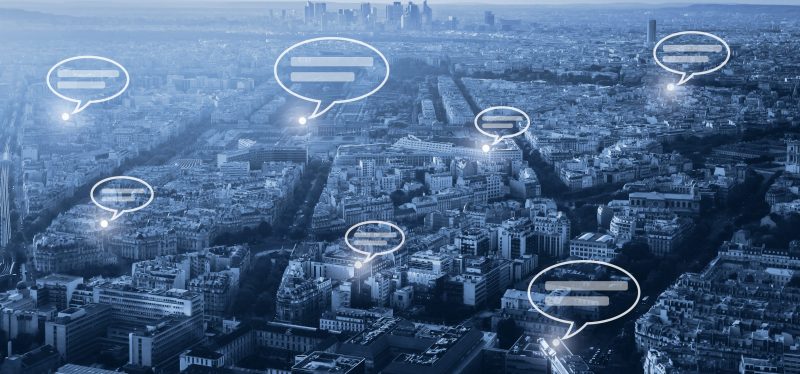 Journalist Scott Fulton III describes fifth-generation wireless, or 5G, as “a capital improvement project the size of the entire planet.”
Journalist Scott Fulton III describes fifth-generation wireless, or 5G, as “a capital improvement project the size of the entire planet.”
He’s not wrong. And it’s coming fast.
What is 5G?
5G is the latest iteration of cellular technology, engineered to exponentially increase the speed (up to 100 times current levels) and responsiveness of wireless networks. It will also facilitate a massive increase in the amount of data transmitted over these networks.
Most importantly for smart cities and communities, 5G is designed from the ground up to support the Internet of Things. So in addition to delivering faster and more data, it will help connect everything from autonomous vehicles and medical equipment to smart trash cans and intelligent lighting.
This increased speed and capacity will require extensive infrastructure investments including “vertical real estate,” like towers and other tall structures; new data centers to process the increased information load; and much more. Global technology analyst and advisory firm Moor Insights & Strategy estimates the infrastructure spending on 5G will exceed $326 billion by 2025.
And it’s on its way…
In December 2017, 3rd Generation Partnership Project (3GPP), the organization that governs cellular standards, released its first formal standards for 5G. Only two things need to happen in order to make this new technology available to the average wireless consumer: mobile operators need to update to 5G gear, and manufacturers need to make 5G-ready devices.
And, according to Digital Trends, carriers including Verizon, AT&T, Sprint and others are already testing 5G in cities around the country. Equipment companies like Nokia, Qualcomm, and Intel are producing prototypes for smartphones, tablets, laptops and more. By 2025, 1.2 billion people are set to have access to 5G networks – a third of them in China, according to the global wireless trade group GSMA.
Consumers are, of course, eager for technology that will let them download movies, games and apps in a fraction of the time it takes today. Meanwhile, military officers believe in its potential for secure communication, saying, “The good news is that when we get to 5G, [wireless networks] will be almost invulnerable.”
Some cities jumped on the 5G bandwagon early and landed new employers, like Racine, Wisconsin’s successful wooing of Foxconn and 13,000 new jobs.
But other cities seem to be dragging their feet.
So why are cities reluctant to embrace 5G?
In the case of Mill Valley, California, a wealthy enclave a few miles north of San Francisco, citizen concerns about cancer and “electromagnetic smog” led its city council to vote unanimously late last week to block deployments of small-cell 5G wireless towers in the city’s residential areas.
A group of activists in New York protested the technology, concerned about historical preservation. Those in other communities expressed anxiety over potential environmental impacts. Some jurisdictions have thrown up roadblocks to deploying installations in public rights-of-way, while others were only too happy to allow it – for a sizable fee.
It’s possible that some communities have leadership that is simply unaware of the opportunities that 5G offers. But in others, industry leaders see clues to larger cultural issues.
A matter of trust
“Cities can be skeptical and hide behind old practices because they’ve been burned. We’re at a point in history where trust is low,” says smart cities expert Chelsea Collier of consulting firm Digi.City. “And cities can understandably be touchy about federal agencies implementing guidelines about small cells inside municipalities. These questions of federal versus states versus local rights have persisted since the founding of our nation.”
She can see the concern, she says. But in the end, “we’re a large land-mass nation growing every single day, with more than 20,000 unique municipalities. To compete as a nation, we need a streamlined regulatory environment.”
Collier draws a comparison between 5G and the US highway system. The federal government has a specific role regarding highways; state transportation departments have their own responsibilities. Cities choose how and where they connect to those highways – but one that wants to grow is not going to opt out of the highway system. The same is true for 5G.
And like a highway, 5G isn’t good or bad, Collier argues. The question is what we do with it.
“Technology is tofu,” she explains. “You can flavor it with almost anything – with personal responsibility or with apathy…Change, and 5G, are coming, whether cities like it or not, so why not co-create what happens next? This is what public-private partnerships are for; this is why we build community.
“Closing the digital divide is so, so important to the future of our cities and to our rural areas. Without 5G, remote education and telemedicine can’t meet their potential. Without it, cities can miss their chance to become a smart city and end up instead as part of the ‘digital Rust Belt.’
“We need to stop fighting over things that don’t matter.”
Jennifer Houlihan is part of the GovLoop Featured Contributor program, where we feature articles by government voices from all across the country (and world!). To see more Featured Contributor posts, click here.





Sounds like an exciting new technology, especially if it can be implemented in ways that reach communities that may currently be underserved when it comes to wireless networks.